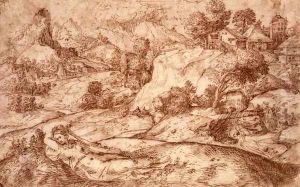Gian Battista Angolo del Moro Paintings
Gian Battista Angolo del Moro, sometimes known as Battista del Moro or simply Angolo del Moro, was an Italian painter of the Renaissance period, born around 1534. His exact birthplace is not well documented, but he was active in the Venetian school, which was one of the most significant artistic centers of the Renaissance era. The Venetian school was renowned for its luminous color palette and innovative use of light and shade, a style that Angolo del Moro would have been exposed to and influenced by during his career.
Not much is known about Angolo del Moro's early life and training. He is thought to have been a pupil of the prominent Venetian painter Titian (Tiziano Vecelli), which would have greatly impacted his artistic style and technique. This connection to Titian suggests that Angolo del Moro's work was rooted in the rich tradition of Venetian painting, characterized by its sensuous color and mastery of chiaroscuro.
Throughout his career, Angolo del Moro's work included religious subjects, portraits, and mythological scenes. However, his artistic output is not well documented, and few works can be securely attributed to him. His style is often noted for its grace and delicacy, with a particular talent for capturing the textures of fabrics and the subtleties of human expression.
Unfortunately, Angolo del Moro's career was relatively short. He died in 1574, and the details surrounding his death are as obscure as those of his life. Nevertheless, as a figure of the Venetian Renaissance, his contributions to the Italian art scene of the 16th century, though not as well-remembered as those of his contemporaries, were part of the rich tapestry of artistic innovation that characterized the period. His works, those that can be attributed to him, continue to be studied by art historians interested in the lesser-known artists of the Venetian school and their impact on the wider Renaissance movement.
